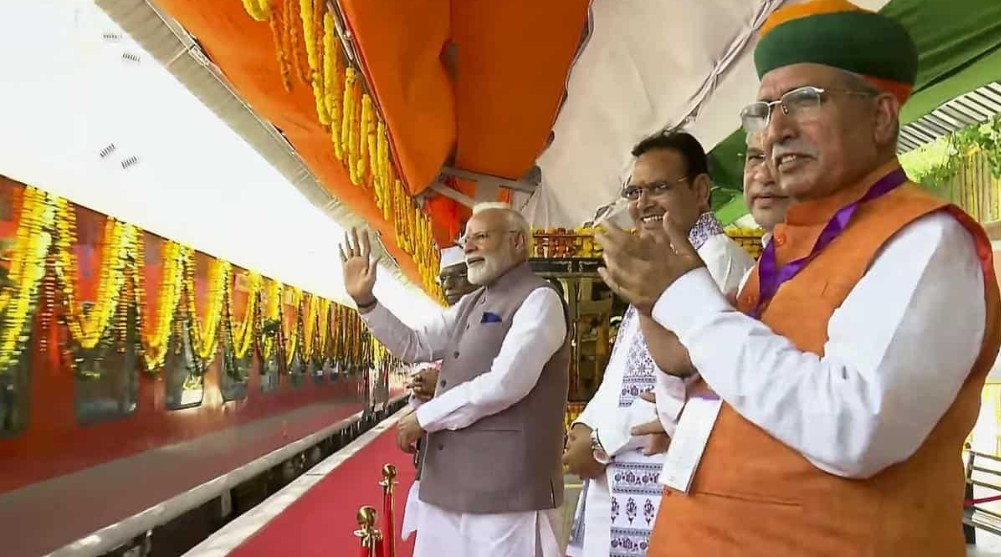PM Modi Highlights Tamil Nadu’s Role in Amrit Bharat Station Scheme
Prime Minister Narendra Modi, during a rally in Thoothukudi on Saturday, July 26, spoke extensively about the Amrit Bharat Station Scheme (ABSS)—a flagship railway infrastructure initiative launched in 2022 to transform Indian railway stations into modern, accessible, and passenger-friendly hubs.
What is the Amrit Bharat Station Scheme?
The Amrit Bharat Station Scheme (ABSS) is a long-term plan introduced by the Ministry of Railways to revamp over 1,300 stations across India. Unlike earlier projects that focused on limited upgrades, ABSS adopted a holistic approach to transform railway stations into future-ready, smart transport hubs.
Each station under ABSS follows a master plan that includes:
- Redesigned and modern circulating areas
- Spacious waiting halls and executive lounges
- Free Wi-Fi and digital display systems
- Energy-efficient lighting and ventilation
- Landscaped surroundings with sustainable design elements
- Multimodal transport integration for seamless last-mile connectivity
- Accessibility features, including lifts, escalators, and ramps for elderly and differently-abled passengers
- Spaces for business lounges, co-working areas, and retail outlets

These developments are tailored to passenger footfall, regional demands, and the economic relevance of each station.
Scope and Progress Across India
As of mid-2025, the government has identified over 1,300 stations for redevelopment under ABSS. In May 2025, the Prime Minister inaugurated 103 redeveloped stations, spanning 86 districts across 18 states and Union Territories, with a combined investment exceeding ₹1,100 crore.
Examples of Stations Covered in Phase-I:
- Andhra Pradesh: Sullurupeta
- Assam: Haibargaon
- Bihar: Pirpainti, Thawe
- Chhattisgarh: Dongargarh, Bhanupratappur, Bhilai, Urkura, Ambikapur
- Gujarat: Samakhiali, Morbi, Hapa, Okha, Mithapur, Rajula Junction, Palitana, Mahuva, and more
- Haryana: Mandi Dabwali
- Himachal Pradesh: Baijnath Paprola
- Jharkhand: Sankarpur, Rajmahal, Govindpur Road
- Karnataka: Bagalkot, Gadag, Dharwad, Gokak Road
- Kerala: Vadakara, Chirayinkeezh
- Madhya Pradesh: Shajapur, Narmadapuram, Katni South, Seoni, Orchha
- Maharashtra: Parel, Chinchpokli, Matunga, Lonand, Dhule, Amgaon
- Puducherry: Mahe
- Rajasthan: Fatehpur Shekhawati, Rajgarh, Bundi, Mandal Garh
- Tamil Nadu: Samalpatti, Tiruvannamalai, Chidambaram, Srirangam, St Thomas Mount, Mannargudi, Polur
- Telangana: Begumpet, Karimnagar, Warangal
- Uttar Pradesh: Saharanpur Junction, Agra Idgah, Bareilly City, Hathras City, Balrampur, Mailani Junction
- West Bengal: Panagarh, Kalyani Ghoshpara, Joychandi Pahar
Why the Scheme Matters
India’s railway network carries over 8 billion passengers annually, but many stations—especially in Tier-2 and Tier-3 cities—have outdated facilities.
The ABSS aims to redefine passenger experience, encourage economic activity around stations, and align railway infrastructure with modern urban planning.
Key Benefits Include:
- Improved regional connectivity
- Boost to domestic tourism
- Support for logistics and freight corridors
- Employment generation through construction and station operations
Tamil Nadu’s Leadership in Station Modernization
With 77 stations under redevelopment, Tamil Nadu is one of the leading states in the ABSS drive. Iconic stations like Chidambaram, Tiruvannamalai, and Srirangam, many with cultural and tourist significance, are expected to benefit immensely.
In the context of Southern India’s growing industrial and trade hubs, the scheme is set to enhance:
- Commuter services for industrial and economic centers
- Access to cultural and temple towns for domestic and international tourists
- Integrated mobility solutions for ports, logistics, and trade routes
Nation-Building Through Rail Infrastructure
The Amrit Bharat Station Scheme is more than a renovation project—it’s a nation-building mission that aligns with India’s vision of becoming a $5 trillion economy.
By modernizing over 1,300 stations, the government aims to prepare Indian Railways for the next 50 years, offering world-class travel experiences while supporting economic growth across rural and urban India.
